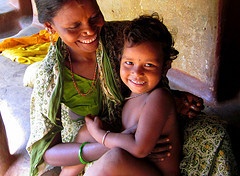This blog story by IFPRI Senior Research Fellow Purnima Menon and Micronutrient Initiative President Venkatesh Mannar was originally posted on The Bill & Melinda Gates Foundation’s Impatient Optimists blog.
The 27 million children born in India this year will grow up in a very different country than the one we grew up in. India has changed more than one would think possible in a lifetime. With progress driven by its 1.2 billion people, India has ascended to become the world’s fourth largest economy. In order for India to continue to grow, we must ensure that the next generation that will drive progress is able to live up to their full physical and intellectual potential.
The 2013 Series on Maternal and Child Nutrition, which we co-authored and was published last month in The Lancet, highlights the staggering contribution of poor nutrition to mortality: almost half of all child deaths in the world today are the result of poor nutrition. Last week, we joined several prominent state, national and global leaders to launch the Lancet Series in India, and to use the Series as an opportunity to highlight India’s urgent need to address the problem that Prime Minister Manmohan Singh has referred to as a “national shame.”
Individually, our personal and professional lives have taken us extensively throughout India, our home country, and we have seen this country striding towards greatness. However, undernutrition remains a significant struggle that keeps people anchored in poverty. Travelling to rural and urban communities with severe development challenges, including malnourished mothers and stunted children, is a tragic reminder that we are only now talking seriously about nutrition.
If we look deeper into the issues, we know that, according to India’s most recent government data (now nearly eight years old), nearly half (46 percent) of Indian children below three years of age are underweight, and 38 percent are stunted. It is not unusual to see children who look to be about a third younger than they should for their years. This has alarming implications for a country that will soon boast the world’s largest workforce; the last thing that India needs is a workforce that is incapable of contributing to and benefiting from India’s growth because we failed to invest in them early enough and well enough. Without the right investments, India risks squandering its massive potential.
The Lancet Series outlines the consequences that result from early malnutrition, yet what truly stands out are the opportunities that an investment in nutrition presents. There is now strong evidence that eliminating undernutrition in young children can boost the GNP of countries, like India, by up to 11%. As The Lancet highlights, India does not even have to look far to see progress. Great strides have been made in key states, including Maharashtra, which successfully reduced stunting from 39% to 23% and severe stunting from 15% to 8% from 2005-06 to 2012, and whose progress is held up as an example in the Series.
Tackling undernutrition requires governments to take a hard look at what must be done to change the austere conditions in which too many young children are growing up. The devastating combination of poverty, poor status of girls and women, food insecurity, especially in vital nutrient-rich foods, poor health services, and abysmal sanitary conditions simply cannot sustain healthy child growth.
At the Series launch in New Delhi, we issued a call to action for India to start this hard look by confronting and quantifying the problem through routine national and sub-national surveillance data collection at least every two to three years, and to use this data to effectively target and monitor progress moving forward. We also called for a stronger commitment to improving governance and strengthening systems to deliver the recommended nutrition-specific and nutrition-sensitive interventions, many of which are already in India’s policy frameworks. This is more about doing things differently than about doing different things. And this call does not stop with India.
As The Lancet Series confirms, malnutrition is not a challenge that any one sector can or should address alone. Working together, we can do more and have a greater impact—a lasting impact. Malnutrition deserves far greater attention and investment by public, private, and civic leaders and citizens than it currently receives. History has shown that the world is capable of great achievement. There are proven solutions within our reach, and our focus on science and economic growth has paid off. Let us now focus on growing and nourishing tomorrow’s leaders, in India and beyond.







